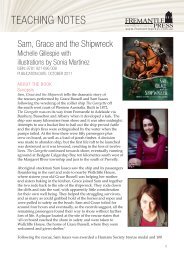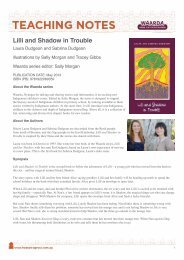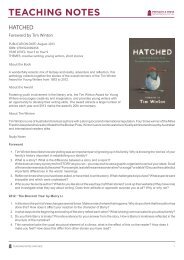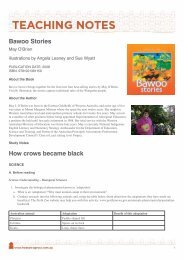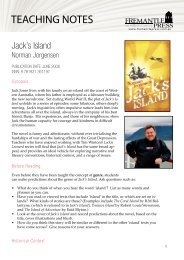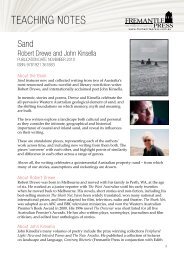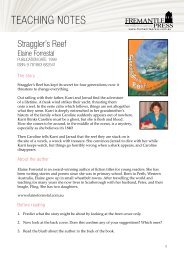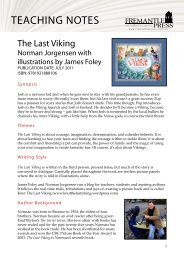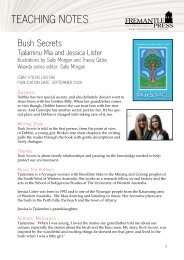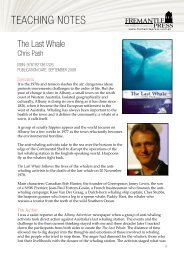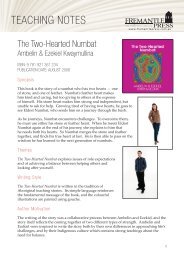DRESS REHEARSAL TEACHING NOTES Web.pdf - Fremantle Press
DRESS REHEARSAL TEACHING NOTES Web.pdf - Fremantle Press
DRESS REHEARSAL TEACHING NOTES Web.pdf - Fremantle Press
You also want an ePaper? Increase the reach of your titles
YUMPU automatically turns print PDFs into web optimized ePapers that Google loves.
<strong>TEACHING</strong> <strong>NOTES</strong><br />
fine independent publishing<br />
www.fremantlepress.com.au<br />
<strong>DRESS</strong> <strong>REHEARSAL</strong><br />
Zoe Thurner<br />
Publication Date: May 2011<br />
ISBN: 9781921696671<br />
ABOUT THE AUTHOR<br />
From the Author<br />
I grew up in Sydney at a time when the new wave of Australian<br />
theatre brought exciting original work to the stage and many<br />
small theatres flourished. From this time I developed a love of<br />
theatre, attended Australian Theatre for Young People and went<br />
to the University of New South Wales to study Psychology and<br />
Drama. After several years I left Sydney to travel around the<br />
country and live in the bush, eventually settling in Perth where I finished<br />
my degree and taught Drama in high schools.<br />
While teaching, I wrote and directed plays for my students and was<br />
lucky to meet lots of creative people doing wonderful work in Youth<br />
Theatre. This inspired me to keep writing and I produced scripts for<br />
school productions, community theatre, professional development and a<br />
primary school education package. I also worked with Playback Theatre<br />
and enjoyed hearing and performing the personal stories of audience<br />
members.<br />
Author Motivation<br />
I wrote the book during a break in drama teaching, and the ideas flowed from my work in<br />
schools and from the dilemmas my students faced. I saw them struggling to establish their<br />
friendships, interests and sense of self in confusing and competitive environments.<br />
I am attracted to the battles people conduct in the course of ordinary life and I wanted<br />
to write a story that was both uplifting and real. I love the way people can be highly<br />
contradictory and also capable of great adaptation and change. There are no true heroes<br />
in the novel and the main character is spirited and flawed. My aim was to write characters<br />
who would discover how to face life in a way that is honest and engaged.<br />
ABOUT THE BOOK<br />
Synopsis<br />
Lara Pearlman lives in a windy coastal town where her father manages the local bank and<br />
her overbearing mother wants to set the rules. But Lara thinks that rules are meant to be<br />
broken and she breaks them loudly and often. Lara raids the pantry, skips school, goes to a<br />
beach party and rides on a motorbike – which disappoints Mrs Pearlman.<br />
1
<strong>TEACHING</strong> <strong>NOTES</strong><br />
fine independent publishing<br />
www.fremantlepress.com.au<br />
Lara flirts with Nathan but really likes Blake. She loves acting, vintage clothes and her best<br />
friend Oggy. But when Oggy is involved in a bank robbery and Blake becomes the prime<br />
suspect, the drama escalates. At the bank, the robber uses Oggy as a human shield and<br />
during the getaway Oggy is rewarded with a fat roll of notes. Though Lara does not want<br />
to see it, Oggy shows her the money and Lara feels torn between friendship and duty.<br />
Lara’s life revolves around her friends and the school play. While Nathan works the<br />
lights and waits patiently in the wings for Lara’s affection, she enters the production to<br />
get close to Blake, with his Ford ute and dubious past. But there is a lot of competition<br />
for Blake’s attention. Lara is rejected and upset by Oggy and Blake as they work closely<br />
together to build ideas for a play based on the theme of World Poverty. The play is finally<br />
brought together under the erratic genius of their teacher but the process makes Lara very<br />
uncertain of the people around her.<br />
Oggy is no stranger to poverty. She struggles to survive on her mother’s meagre income as<br />
a violin teacher. And Oggy is not the only one struggling to survive in a town divided into<br />
the haves and have-nots.<br />
But wealth is no protection against misfortune either. When the girls go to a beach party<br />
with Chelsea, the daughter of a powerful land developer, Chelsea accepts a lift home with<br />
three drunken louts. Lara’s father is late coming to fetch Lara and the girls follow Chelsea<br />
into the car. The driver detours down dirt roads. Lara is terrified. She has to jump from the<br />
moving car to escape and rescues Oggy by dragging her into the bush. But Chelsea is too<br />
drunk to flee and does not return home.<br />
In the aftermath of the abduction and through the course of the play Lara’s beliefs are<br />
turned upside down. She comes to realise that being reliable is not as boring as it seems.<br />
Then as the town continues to hunt for the robbers Lara stumbles across their identity. It<br />
is the final moment of discovery for Lara about herself, her circle of friends and what she<br />
truly values.<br />
STUDY <strong>NOTES</strong><br />
Overview: the use of the book in the curriculum<br />
The book lends itself to study in the following areas:<br />
I English<br />
• Study of characterisation: dialogue, action, appearance<br />
• Study of setting: place, natural environments<br />
• Study of plot development and structure: plotting a mystery<br />
• Study of figurative language: metaphor, simile, assonance, personification, symbol<br />
II Drama<br />
• Study of the processes and problems of producing youth theatre<br />
• Ideas for developing drama based on the theme of the Depression<br />
• Study and performance of dramatic monologue and duologue<br />
2
<strong>TEACHING</strong> <strong>NOTES</strong><br />
fine independent publishing<br />
www.fremantlepress.com.au<br />
III Values in Education<br />
• Exploration of the problems related to the use of drug and alcohol during adolescence<br />
(in particular those related to driving)<br />
• Learning protective behaviour<br />
• The importance of making discerning choices<br />
• Comparison and exploration of conflict resolution in families<br />
I English<br />
COMPREHENSION<br />
Pre-reading<br />
1. Before you start reading the novel, have a look at the cover. Look closely at the textures,<br />
patterns, colours, font and illustration. What style is evoked by the cover What do you<br />
think the novel could be about Who do you think the target audience for this novel<br />
might be<br />
2. Have a look at the title: Dress Rehearsal. What ideas does it give you about the<br />
3.<br />
story What is a dress rehearsal On p. 252 the main character is told: ’You treat your<br />
friendship with Nathan like it’s some sort of dress rehearsal.’ What do you think this<br />
means<br />
Read the blurb. What do you learn about the story Does the blurb make you want to<br />
read the novel Why or why not<br />
Chapters 1–10<br />
Key quote: p. 90 ’There’s a razzle-dazzle of light and sound and I pick us, this moment,<br />
our friendship, our pact against the world. I jump ship from my world to hers because<br />
I believe her world is the one that really exists.’ In the opening chapters the reader<br />
is introduced to Lara’s world. What does this quote indicate about Lara’s regard for<br />
friendship and herself<br />
Focus questions:<br />
1. What do you find out about the main character, Lara, in the first chapter What do you<br />
learn about her personality, conflicts, interests What else would you like to find out<br />
about her<br />
2. A lot of characters are introduced in the first three chapters. Make a table of the<br />
characters to show their names, a few words to describe their personality and their<br />
relationship to Lara. What role do you think these characters will play in the story<br />
How do you think their relationship with Lara will develop<br />
3. Lara’s relationship with her mother is strained. They disagree on a number of issues.<br />
What are these issues Describe the differences in their personalities. Do you find it<br />
believable Why or why not<br />
4. Compare and contrast Oggy and Chelsea. Predict the role each may play as the novel<br />
develops. How do they fit into the social hierarchy of the school and town<br />
5. What aspects of small country towns are featured in the novel How does this impact<br />
on how the characters behave<br />
6. In Chapter 9 Oggy shares a secret with Lara. What do you think Lara will do about it<br />
Make a detailed prediction based on what you have already read.<br />
3
<strong>TEACHING</strong> <strong>NOTES</strong><br />
fine independent publishing<br />
www.fremantlepress.com.au<br />
Chapters 11–20<br />
Key Quote: p. 109 ‘[My mother]’s afraid I will become something she cannot control. But<br />
that’s not my fault and I can’t help her.’ In the middle section of the novel, Lara takes risks<br />
with some momentous outcomes. Why do you think she does so<br />
Focus questions:<br />
1. List in chronological order the events that have occurred so far.<br />
2. Some major events shift Lara’s perception of herself and those around her. What are the<br />
events and what impact do they have Provide evidence for your answer with quotes<br />
from the novel.<br />
3. Oggy and Lara are best friends but there are difficulties and tensions between them,<br />
which finally erupt at the beach party. Identify the differences between the two girls.<br />
Trace the events and tensions that lead to the argument.<br />
4. Create a character map of Lara’s mother. Annotate the drawing with a written analysis<br />
of her attitudes, values, appearance and role in Lara’s life.<br />
5. Read pp. 107–109. Consider the revelation Lara’s mother makes. What does this tell us<br />
about her How does this influence her behaviour towards Lara Find evidence from<br />
the text to support this.<br />
6. Identify how figurative language is used throughout Chapter 12 to describe minor<br />
characters. Quote from the text to justify your answer.<br />
7. Read Chapter 16 closely and annotate moments of tension. How is pace created How<br />
is the reader positioned to respond<br />
8. Is it easy to empathise with Chelsea’s character<br />
Chapters 21–32<br />
Key quote: p. 165: ‘I’ve discovered recently that sometimes people aren’t who you think<br />
they are.’ In the context of the novel, what does this quote indicate about Lara’s journey in<br />
relation to herself<br />
Focus questions:<br />
1. If Tom was able to talk about what was going on, what might he say to Lara and<br />
Nathan when they visit him at home Read Chapter 22.<br />
2. Lara finds it difficult to tell her father the truth. What choice does she make and why<br />
What would you do<br />
3. Lara has to confront her mistakes. What does she finally realise about herself in relation<br />
to Chelsea and Nathan<br />
4. Rewrite a scene from Drama Camp – from Nathan’s point of view.<br />
5. The crisis in Lara’s relationship with Nathan peaks during Drama Camp. Read p. 246<br />
and describe the understanding that Lara comes to at this moment. Explain how it<br />
symbolises other issues and conflicts in her life.<br />
6. The identity of the robber is not revealed until the final pages. Before reading the last<br />
chapter, predict who the robber could be. What clues lead you to your conclusion<br />
7. Identify devices used to mislead the reader about the identity of the robber. What was<br />
the author’s intention<br />
4
<strong>TEACHING</strong> <strong>NOTES</strong><br />
fine independent publishing<br />
www.fremantlepress.com.au<br />
CHARACTERS<br />
The writer uses figurative language, often with symbolic overtones, to describe how<br />
characters look, act and speak. Dialogue is used to great effect in this book and is rarely<br />
broken by descriptive passage. It appears like a playscript which invites direct entry into<br />
the thoughts and feelings of the characters. Consider the following examples:<br />
Appearance:<br />
• Oggy: p. 10 ‘Oggy is very small, very white, with huge feet. Today she’s wearing a<br />
knitted cardigan and her steel tipped-boots.’<br />
• Mother: p. 101 ’the glassy skin over the ridge of her brow is almost bald. Her sunken<br />
eyes have been left unprotected.’<br />
• Dan: p. 54 ‘His fists are as big as bowling balls’<br />
Action:<br />
• Man at the auction: p. 211 ‘Though his breath whistles between foxy teeth, the old<br />
bloke has the presence of mind to overcharge us.’<br />
• Mr Hatherly: p. 13 ‘He’s always leaning against something as if he can’t support the<br />
weight of his feelings.’<br />
Speech:<br />
Dialogue<br />
• The family interactions at the restaurant (Chapter 13, pp. 110–111)<br />
• The conversations between Lara and her mother (Chapter 3, pp. 17–20 and Chapter 13,<br />
pp. 107–109)<br />
• Oggy revealing her secret to Lara (pp. 86–89)<br />
• Oggy and Lara arguing (Chapter 24)<br />
Monologue<br />
• Mrs Kaye’s speech (p. 92)<br />
• Lara’s speech at the police station (p. 76)<br />
• Mother’s speech to Nathan waiting for Lara to return (p. 61)<br />
Activities<br />
1. Using the examples above, identify the literary devices used to create believable characters.<br />
2. Choose one of the examples of dialogue and analyse how it is used to further the<br />
action, raise the tension and reveal the characters’ thoughts and feelings.<br />
3. Consider the subtext of the speeches. What is being suggested but not said<br />
4. Read one of the monologues. What impression do you have of the character and what<br />
is suggested about their situation or environment<br />
5. What do you think Lara means when she says that she sees Tom ‘disappear without<br />
leaving the room. Tom worries me’ (p. 33) What impression does this give you What<br />
kind of person do you think Tom might be and what has made him like this How does<br />
this picture of him play out through the novel<br />
6. In Chapter 6 we see Lara move from loneliness to joy then despair. Lara’s emotions are<br />
intense and she tends to make impulsive decisions. Later she tells Nathan that ‘I have<br />
to follow myself around and find things out as they happen’ (p. 266). How does this<br />
quality impact on her life and the events that happen Do you think that Oggy operates<br />
in the same way Find evidence from the text to support your answer.<br />
5
<strong>TEACHING</strong> <strong>NOTES</strong><br />
fine independent publishing<br />
www.fremantlepress.com.au<br />
7.<br />
A number of characters reveal themselves to be different to what they seem. They grow<br />
and change. Pick one of the following minor characters and chart their development.<br />
Use Photoshop to create a character map.<br />
Mother – Chapters: 3, 12, 13, 17, 28 / Blake – Chapters: 6, 7, 14, 29 /<br />
Mrs Kaye – Chapters: 11, 21 / Chelsea – Chapters: 2, 6, 16, 18, 21, 27<br />
SETTING<br />
Activities<br />
1. Create a map of the town and its environment.<br />
2. Look at the following examples and discuss how the author has used literary devices to<br />
create a picture and a sense of place.<br />
• The town: p. 24 ‘Oggy says our town is ordinary but I love Point Jerome. It’s like a<br />
badly pegged tent stretched over lumpy ground that sits across two hills and a bay.‘<br />
• Duke Street: p. 72 ’At the bottom of Duke Street, gulls chip into the ragged face of the bay.’<br />
• Dan’s house: p. 54 ’The cottage floats in swamp lilies and I don’t think I want to go<br />
inside if it’s like the shed, but I’m shocked: the interior is immaculate.’<br />
3. Using one of the following examples analyse the literary devices used to create a sense<br />
of place.<br />
• Oggy’s House: Chapter 7, p. 51<br />
• Lara’s House: Chapter 9, p. 81<br />
• Tom’s House: Chapter 22, pp. 169–171<br />
• Duke Street: Chapter 19, p. 149<br />
• The Cliffs: Chapter 27, pp. 214–215<br />
TENSE AND POINT OF VIEW<br />
Present tense was chosen to create a sense of momentum and urgency. The novel is written<br />
in the first person and reads almost like a dramatic monologue. It invites the reader into<br />
Lara’s most intimate thoughts. Lara does not hold back in her emotive, often scathing and<br />
rather witty descriptions of her family and friends.<br />
THEMES<br />
The following themes are explored throughout the novel as the characters confront their<br />
vulnerability and make choices in response to the difficulties they encounter.<br />
• Identity and selfhood<br />
• Friendship and loyalty<br />
• Family relationships<br />
• Development of personal values<br />
• Revelation of true nature and character<br />
• Rebellion and peer pressure<br />
• Self protection and preservation<br />
CREATIVE WRITING<br />
Activities<br />
1. Choose one of the themes from the novel as the basis for a short story.<br />
2. Write four diary entries from either Chelsea’s or Blake’s perspective. Include entries<br />
about their feelings and about the other people in the play. Elaborate on their hopes,<br />
dreams and fears.<br />
6
<strong>TEACHING</strong> <strong>NOTES</strong><br />
fine independent publishing<br />
www.fremantlepress.com.au<br />
3. Write a character reference to be read in court for either Oggy, Tom or Petra OR Write<br />
the defence presented by Oggy’s lawyer at court.<br />
4. Write a news article about the robberies for the Point Jerome Chronicle.<br />
5. Write a travel article about Point Jerome for a city newspaper OR Think about a place<br />
you have visited and write a feature article for the travel section of a newspaper<br />
describing the place and people in an engaging way.<br />
6. There is going to be a big house and land auction in Point Jerome. The houses where<br />
Oggy, Lara, Tom and Blake live are all up for sale. Write a speech for a real estate agent<br />
who has to promote the sale.<br />
7. Produce the poster for the school play about World Poverty.<br />
8. Create a programme for the play about World Poverty. Remember to include<br />
programme notes on the purpose, design and scenes in the play.<br />
9. Write a review of the play that the students in the novel produce.<br />
10. Imagine what Dan might like to say about his life and write a piece of memoir. Write<br />
a letter from Dan to Blake for a special birthday in which he tells him about their<br />
childhood home and siblings, early life together and what it has been like to be his<br />
brother’s guardian.<br />
Extension<br />
1. Dress Rehearsal presents a view of the world in which the ordinary symbolises the<br />
extraordinary. Explain this statement with reference to the text.<br />
2. Identify descriptive passages for three male characters and discuss how the audience is<br />
positioned to respond.<br />
3. Define the main characters’ motivations under the terms of reason, spirit and desire.<br />
4. Explore how minor characters are used in the novel. What motivates their choices Are<br />
they realistic<br />
5. Create a PowerPoint presentation analysing the photographs of Dorothea Lange<br />
depicting the Depression in America.<br />
6. Research the events that shaped the Depression. Write an analytical essay about the<br />
context of the play that the students in the novel create.<br />
7. Lara’s parents make more mistakes than she does. Do you agree or disagree Discuss.<br />
DEBATE<br />
Statement 1: Forgiveness is the greatest of values. (Discuss in context of Lara’s growth and<br />
development.)<br />
Statement 2: Tom’s background is a reasonable excuse for his actions.<br />
Statement 3: Oggy should be severely punished for keeping the stolen money.<br />
Statement 4: You should work out your own problems first without parental help.<br />
Statement 5: Young people who are convicted of crimes should always be incarcerated.<br />
Statement 6: You are always responsible for your own mistakes.<br />
II Drama<br />
Activities<br />
1. Create a role-play to explore one central theme from the novel OR Using character and<br />
context from the novel as an initial reference, create a montage of scenes in which the<br />
conflict unfolds.<br />
7
<strong>TEACHING</strong> <strong>NOTES</strong><br />
fine independent publishing<br />
www.fremantlepress.com.au<br />
2. Analyse the dialogue in pp. 110–111, p. 92, p. 61 and create a duologue in response.<br />
3. Choose one character from the novel and create a dramatic monologue which<br />
engenders sympathy but also reveals their flaws.<br />
4. Choose a passage from the novel and convert into a script. Re-enact the scenes and<br />
extend them, e.g.: Chapter 17: The Wilsons, Chapter 23: Dance practice.<br />
5. Write a dramatic monologue for Mr Hatherly’s play. You will need to research the<br />
Depression in Australia. It might be based on a memoir of someone who lived through<br />
that time. As a basis for your writing read Margaret’s monologue in Nicholas Enright’s<br />
play about the Depression, On The Wallaby.<br />
6. Research the topic of World Poverty and write a contemporary dramatic monologue on<br />
the theme. It might be written from the perspective of:<br />
• A refugee<br />
• A person living on welfare or in poverty in contemporary Australia. Consider their<br />
circumstances, background, psychological state.<br />
• A political activist<br />
7. A lie is easier to tell than the truth. Analyse this statement with reference to the text.<br />
Create a role-play based on this theme.<br />
8. Lara’s perceptions begin to change after a major crisis. She says: ‘I realise that I’ve<br />
thought about Nathan a lot in the last twenty-four hours and that it probably means<br />
something. I guess it means that being reliable is important, not boring, like I thought it<br />
did’ (p. 138). Create a drama showing a change in understanding following a crisis.<br />
9. Create the court scene in which Oggy and the robbers are brought to trial. Develop<br />
their defence.<br />
10. Lara presents a poem at rehearsal to reflect the theme of the show and to share her<br />
intense emotions. Find a poem which interests you. Create a series of scenes based<br />
on your poem using sound, movement and dialogue. Incorporate the poem into your<br />
performance.<br />
III Values in Education<br />
Activities<br />
1. Research statistics on the impact of poverty on families in Australia.<br />
2. In groups, identify the organisations that support families in crisis. Each group should<br />
give a speech to present their findings.<br />
3. In groups, create a poster identifying the qualities of positive friendship choices.<br />
4. Research the juvenile justice system in Australia and create a case study for either Oggy<br />
or Tom or Petra.<br />
5. Research the wider variety of issues concerning youth and road safety.<br />
6. Using information about road safety from your local agents, create a poster promoting<br />
safe practice around one issue concerning road safety, e.g. drink driving, speeding,<br />
wearing seatbelts, driver responsibility, passenger etiquette and conduct.<br />
7. In pairs, identify the choices, actions and peer pressure which lead to the girls<br />
accepting a lift with a drunk driver in the novel. Discuss the strategies the characters<br />
could have used to prevent this. Present your findings in a table.<br />
8. The boys in this novel vary in their attitudes, values and beliefs. Choose two male<br />
characters and compare and contrast these in each character. How do their beliefs and<br />
values inform their choices and actions Quote from the text to justify your answer.<br />
8




